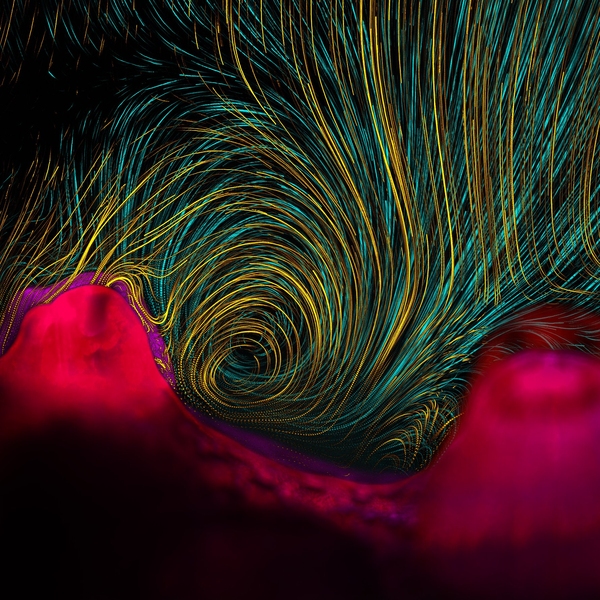Seeking to make the invisible visible, scientists in Professor Roman Stocker’s lab used video microscopy to reveal the path of water as it flows around coral. The resulting image, “Invisible Coral Flows,” is winner in the photography category of the 2013 International Science and Engineering Visualization Challenge, sponsored by the National Science Foundation (NSF) and the American Association for the Advancement of Science, and appears on the cover of the Feb. 7 issue of Science.
In his research, Stocker, an associate professor in the Department of Civil and Environmental Engineering, uses microfluidics and imaging to document and quantify the often overlooked dynamic roles played by ocean microbes, coral, and other marine life forms whose individual impacts at the small scale may profoundly affect ocean health and biogeochemical cycles at larger scales.
“Seeing and sharing what are otherwise ‘invisible’ environmental processes by directly capturing them through microscale photography is not only very gratifying, but also opens the door to a deeper understanding of these processes and how they affect whole ecosystems, like, in this case, coral reefs,” says Stocker. “When we saw these flows that the corals generate, and how effectively they allow the corals to mix their surroundings, we were stunned.”
Working in Stocker’s Environmental Microfluidics Lab, postdoc Vicente Fernandez and former postdoc Orr Shapiro (now at the Weizmann Institute of Science in Israel) created the winning image as part of a study on how corals engineer their environment.
Fernandez and Shapiro placed Pocillopora damicornis coral in seawater containing tiny nutrient particles under the lens of a microscope. They then used video to capture the slight movement of two coral polyps (each about a millimeter in size) and the dynamic flow of particles in the water around them over a 90-minute period.
Fernandez superimposed information from the short video clips at the beginning and end of the experiment to create a single image showing the coral’s movement and the paths of the particles’ flow. Unseen in the image are the thousands of tiny cilia covering the coral’s surface that stir the water with their oscillations. He later applied colors to the image in a palette based loosely on Andy Warhol’s iconic 1967 silkscreen series of the actress Marilyn Monroe.
“It was a striking example of a minimalist color palette with strong contrasting elements, exactly what we needed to depict our complex coral landscape,” Fernandez says.
The red coral surface and gold particle tracks show the coral and fluid flow at the beginning of the experiment, while the purple and blue represent the coral and particles at the end of the period. The presence of the vortex at both points in time indicates that the water flow generated by the coral’s cilia is a consistently robust feature of the microenvironment. The proximity of the dots to one another indicates how quickly water flowed; particles further away from one another indicate faster movement.
MIT postdoc Melissa Garren and Assaf Vardi of the Weizmann Institute were also involved in the coral research.
For more information about the image and the technique behind it, please visit the NSF competition page.
In his research, Stocker, an associate professor in the Department of Civil and Environmental Engineering, uses microfluidics and imaging to document and quantify the often overlooked dynamic roles played by ocean microbes, coral, and other marine life forms whose individual impacts at the small scale may profoundly affect ocean health and biogeochemical cycles at larger scales.
“Seeing and sharing what are otherwise ‘invisible’ environmental processes by directly capturing them through microscale photography is not only very gratifying, but also opens the door to a deeper understanding of these processes and how they affect whole ecosystems, like, in this case, coral reefs,” says Stocker. “When we saw these flows that the corals generate, and how effectively they allow the corals to mix their surroundings, we were stunned.”
Working in Stocker’s Environmental Microfluidics Lab, postdoc Vicente Fernandez and former postdoc Orr Shapiro (now at the Weizmann Institute of Science in Israel) created the winning image as part of a study on how corals engineer their environment.
Fernandez and Shapiro placed Pocillopora damicornis coral in seawater containing tiny nutrient particles under the lens of a microscope. They then used video to capture the slight movement of two coral polyps (each about a millimeter in size) and the dynamic flow of particles in the water around them over a 90-minute period.
Fernandez superimposed information from the short video clips at the beginning and end of the experiment to create a single image showing the coral’s movement and the paths of the particles’ flow. Unseen in the image are the thousands of tiny cilia covering the coral’s surface that stir the water with their oscillations. He later applied colors to the image in a palette based loosely on Andy Warhol’s iconic 1967 silkscreen series of the actress Marilyn Monroe.
“It was a striking example of a minimalist color palette with strong contrasting elements, exactly what we needed to depict our complex coral landscape,” Fernandez says.
The red coral surface and gold particle tracks show the coral and fluid flow at the beginning of the experiment, while the purple and blue represent the coral and particles at the end of the period. The presence of the vortex at both points in time indicates that the water flow generated by the coral’s cilia is a consistently robust feature of the microenvironment. The proximity of the dots to one another indicates how quickly water flowed; particles further away from one another indicate faster movement.
MIT postdoc Melissa Garren and Assaf Vardi of the Weizmann Institute were also involved in the coral research.
For more information about the image and the technique behind it, please visit the NSF competition page.






